|
|
Post by Admin on Mar 4, 2017 20:32:18 GMT
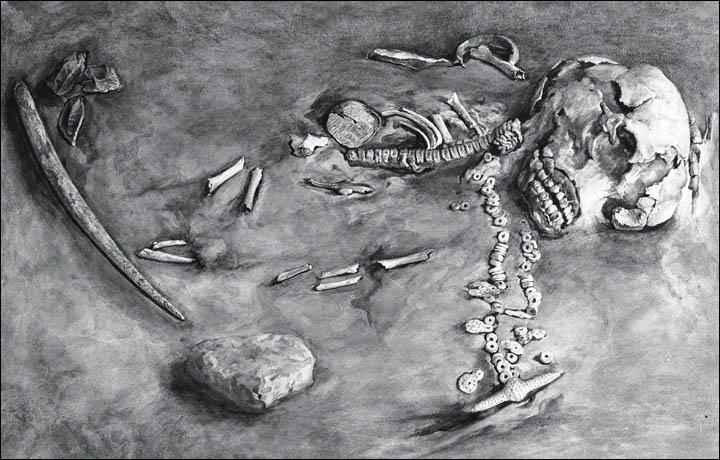 New DNA findings, if confirmed, have stunning implications for our understanding of both pre-historic Siberians - and native Americans. They would suggest that, contrary to previous understanding, some indigenous populations are - in fact - European or West Asiatic in origin. The Danish-US research was carried out on the bones of a Siberian boy whose remains were found near the village of Mal'ta close to Lake Baikal in the 1920s in a grave adorned with flint tools, pendants, a bead necklace and a sprinkling of ochre. The remains are held in the world famous Hermitage Museum in St Petersburg and analysis of a bone in one of his arms represents 'the oldest complete genome of a modern human sequenced to date', according to Science magazine.  'His DNA shows close ties to those of today's Native Americans. Yet he apparently descended not from East Asians, but from people who had lived in Europe or western Asia,' said ancient DNA expert Eske Willerslev of the University of Copenhagen. 'The finding suggests that about a third of the ancestry of today's Native Americans can be traced to 'western Eurasia'.' The research may help explain why 'European ancestry previously detected in modern Native Americans do not come solely from mixing with European colonists, as most scientists had assumed, but have much deeper roots', said the report.  Russian scientists reconstructed her to show what many were surprised to be a European face, unrelated to the modern day Altai tribes. The finding is confirmed by DNA analysis which showed her to be Pazyryk in origin. Her group was part of the Samoyedic family, with elements of the Iranian-Caucasian substratum'. The four year old boy was found near the Belaya River close to the village of Mal'ta which is famed for the discovery of ancient art, some of it showing close links to European discoveries of the same period. Willerslev and co-author Kelly Graf of Texas A&M University 'used a variety of statistical methods to compare the genome with that of living populations. 'They found that a portion of the boy's genome is shared only by today's Native Americans and no other groups, showing a close relationship. 'Yet the child's Y chromosome belongs to a genetic group called Y haplogroup R, and its mitochondrial DNA to a haplogroup U. Today, those haplogroups are found almost exclusively in people living in Europe and regions of Asia west of the Altai Mountains, which are near the borders of Russia, China, and Mongolia.' 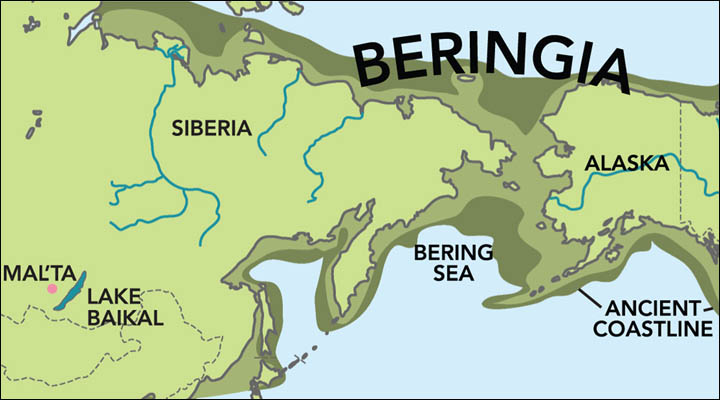 Willerslev and his team propose that earlier than 24,000 years ago 'the ancestors of Native Americans and the ancestors of today's East Asians split into distinct groups. 'The Mal'ta child represents a population of Native American ancestors who moved into Siberia, probably from Europe or west Asia. Then, sometime after the Mal'ta boy died, this population mixed with East Asians. The new, admixed population eventually made its way to the Americas.' The timing is uncertain but 'the deep roots in Europe or west Asia could help explain features of some Paleoamerican skeletons and of Native American DNA today'. Some of the traces of Eurasian genetic signatures in modern Native Americans do not come from colonial times when incoming Europeans mixed with the indigenous population. Yet perhaps the findings - the full details of which are due to be published soon in Nature journal - are not so surprising. Famed Russian archeologist Mikhail Gerasimov found art work at Mal'ta which show a close resemblance to European female figurines of the Upper Paleolithic period. The similarities extend to tools and dwelling structures. 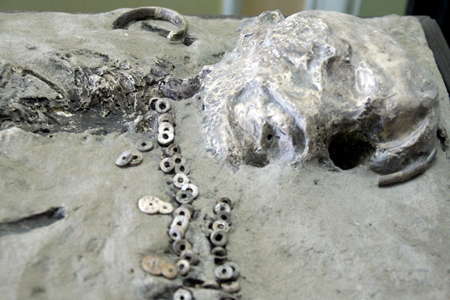 |
|
|
|
Post by Admin on Mar 21, 2017 19:56:59 GMT
 The principal component analysis whose results are plotted below confirms the findings of my calculator and admixture analyses. The analysis includes ancient and modern Amerindian and Caucasoid samples. Some of the Mayan, Bolivian, and Quechua samples, which my admixture analyses have shown to contain up to 17% European admixture, are shifted to the right of the more pure Amerindian samples, toward the Caucasoid samples. To the right of them is a Mixtec sample which is 23.5% European, and to the right of that Mixtec sample is the 30% European Chinchorro mummy sample, and also the Pericú sample BC23, which my admixture analyses have also consistently shown to have a significant amount of European admixture. 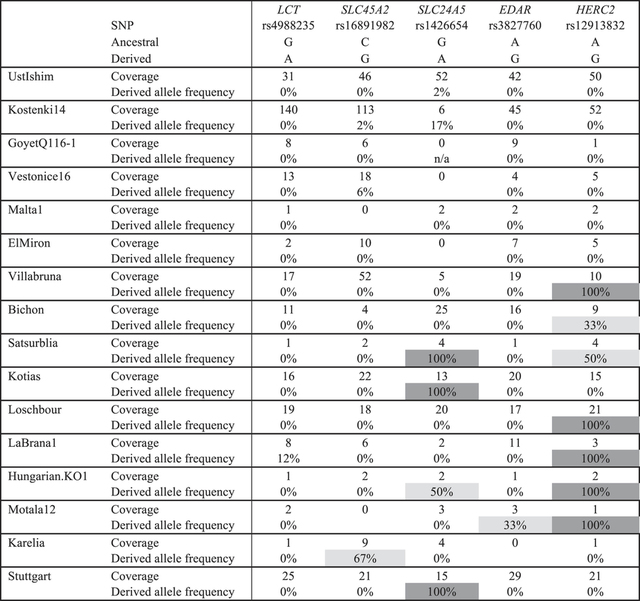 Extended Data Table 5: Allele counts at SNPs affected by selection in individuals with >1-fold coverage rs4988235 is responsible for lactase persistence in Europe60, 61. The SNPs at SLC24A5 and SLC45A2 are responsible for light skin pigmentation. The SNP at EDAR62, 63 affects tooth morphology and hair thickness. The SNP at HERC2 (refs 64, 65) is the primary determinant of light eye colour in present-day Europeans. We present the fraction of fragments overlapping each SNP that are derived; the observation of a low rate of derived alleles does not prove that the individual carried the allele, and instead may reflect sequencing error or ancient DNA damage. Sites highlighted in light grey were judged (based on the derived allele count) likely to be heterozygous for the derived allele, and dark grey sites are likely to be homozygous.  This analysis is consistent with the results from a previous study by Raghavan et al. (2014) which estimated that 14 to 38% of Native American ancestry may originate through gene flow from the ancient population associated with MA-1. MA-1 is basal to modern-day western Eurasians and it carried mtDNA haplogroup U, which is common among European hunter-gatherers. But European admixture detected in Chinchorro DNA samples does not translate into typical European physical traits. According to Fu et al. (2016), MA-1 completely lacks light-skin mutations such as SLC45A2, SLC24A5 and HERC2.  Note that in this plot the Chinchorro mummy sample has a positive value of the second principal component, making it shifted in the direction of European rather than Middle Eastern Caucasoids. Below is another PCA plot, with the Caucasoid samples restricted to those having a positive value of the second principal component in the first plot, which excludes the Middle Eastern samples, leaving only the European samples. The positions of the Amerindian samples are similar, but now BC23 is horizontally between the Mixtec sample and the Chinchorro mummy sample. 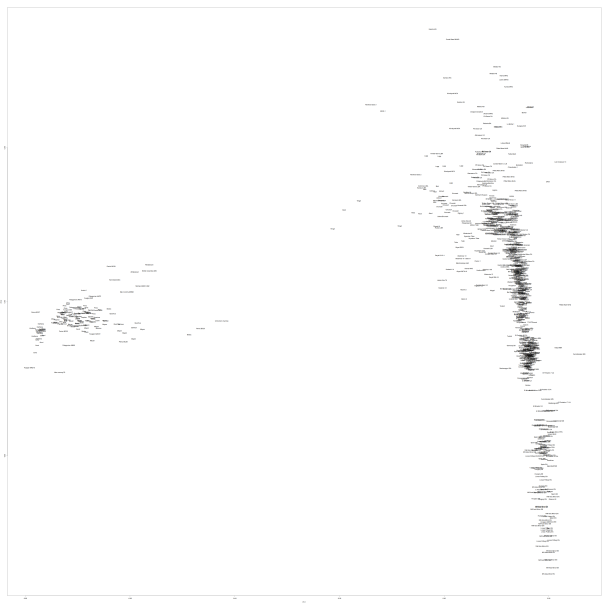 |
|
|
|
Post by Admin on Apr 27, 2017 20:13:37 GMT
A startling new report asserts that the first known Americans arrived much, much earlier than scientists thought — more than 100,000 years ago __ and maybe they were Neanderthals. If true, the finding would far surpass the widely accepted date of about 15,000 years ago. Researchers say a site in Southern California shows evidence of humanlike behavior from about 130,000 years ago, when bones and teeth of an elephantlike mastodon were evidently smashed with rocks. 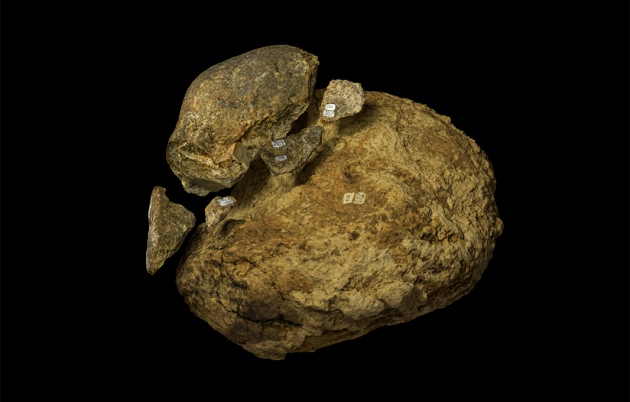 The earlier date means the bone-smashers were not necessarily members of our own species, Homo sapiens. The researchers speculate that these early Californians could have instead been species known only from fossils in Europe, Africa and Asia: Neanderthals, a little-known group called Denisovans, or another human forerunner named Homo erectus. “The very honest answer is, we don’t know,” said Steven Holen, lead author of the paper and director of the nonprofit Center for American Paleolithic Research in Hot Springs, South Dakota. No remains of any individuals were found.  Whoever they were, they could have arrived by land or sea. They might have come from Asia via the Beringea land bridge that used to connect Siberia to Alaska, or maybe come across by watercraft along the Beringea coast or across open water to North America, before turning southward to California, Holen said in a telephone interview. Some archaeologists, however, maintain that humans arrived earlier. They point to sites containing rocks that resemble stone tools as well as large animal bones that have damage apparently inflicted by humans. Deméré's co-authors Kathleen Holen and her husband Steven Holen, archaeologists at the Center for American Paleolithic Research in Hot Springs, South Dakota, have put forward several sites in the US Midwest as evidence for a human presence in the Americas up to 40,000 years ago3. But many scientists have viewed these claims with scepticism. After hearing about the San Diego mastodon, the Holens visited Deméré in 2008 to see the boxed-up remains. “We were looking at something very, very old, but it had the same fracture patterns that we had seen before,” says Kathleen Holen. The bones looked as though they had been set on by a large ‘anvil’ stone and struck with a ‘hammer’ rock. The team contends that the rocks recovered from the site were used either to extract the mastodon’s bone marrow or for making more-delicate bone tools. There are no obvious cut marks on the mastodon bone, suggesting that the animal wasn’t killed or butchered for its meat. Using refined dating methods, the researchers tried again to determine the age of the site. They couldn’t use radiocarbon dating on the mastodon remains because the bones lacked carbon-containing collagen protein. A second method was too imprecise. A third technique, which measures relative levels of radioactive uranium and thorium in bone, suggested that the remains are 130,000 years old. “I’m sure that many of our colleagues are going to be quite sceptical. I would expect that. This is far, far older than most archaeologists expect hominins to be in North America,” says Steven Holen. “I say that even for myself.”  The earliest dispersal of humans into North America is a contentious subject, and proposed early sites are required to meet the following criteria for acceptance: (1) archaeological evidence is found in a clearly defined and undisturbed geologic context; (2) age is determined by reliable radiometric dating; (3) multiple lines of evidence from interdisciplinary studies provide consistent results; and (4) unquestionable artefacts are found in primary context1, 2. Here we describe the Cerutti Mastodon (CM) site, an archaeological site from the early late Pleistocene epoch, where in situ hammerstones and stone anvils occur in spatio-temporal association with fragmentary remains of a single mastodon (Mammut americanum). The CM site contains spiral-fractured bone and molar fragments, indicating that breakage occured while fresh. Several of these fragments also preserve evidence of percussion. The occurrence and distribution of bone, molar and stone refits suggest that breakage occurred at the site of burial. Five large cobbles (hammerstones and anvils) in the CM bone bed display use-wear and impact marks, and are hydraulically anomalous relative to the low-energy context of the enclosing sandy silt stratum. 230Th/U radiometric analysis of multiple bone specimens using diffusion–adsorption–decay dating models indicates a burial date of 130.7 ± 9.4 thousand years ago. These findings confirm the presence of an unidentified species of Homo at the CM site during the last interglacial period (MIS 5e; early late Pleistocene), indicating that humans with manual dexterity and the experiential knowledge to use hammerstones and anvils processed mastodon limb bones for marrow extraction and/or raw material for tool production. Systematic proboscidean bone reduction, evident at the CM site, fits within a broader pattern of Palaeolithic bone percussion technology in Africa3, 4, 5, 6, Eurasia7, 8, 9 and North America10, 11, 12. The CM site is, to our knowledge, the oldest in situ, well-documented archaeological site in North America and, as such, substantially revises the timing of arrival of Homo into the Americas. Nature 544, 479–483 (27 April 2017) |
|
|
|
Post by Admin on May 30, 2017 19:46:25 GMT
 The timing of the first entry of humans into North America across the Bering Strait has now been set back 10,000 years. This has been demonstrated beyond a shadow of a doubt by Ariane Burke, a professor in Université de Montréal's Department of Anthropology, and her doctoral student Lauriane Bourgeon, with the contribution of Dr. Thomas Higham, Deputy Director of Oxford University's Radiocarbon Accelerator Unit.  The earliest settlement date of North America, until now estimated at 14,000 years Before Present (BP) according to the earliest dated archaeological sites, is now estimated at 24,000 BP, at the height of the last ice age or Last Glacial Maximum. The researchers made their discovery using artifacts from the Bluefish Caves, located on the banks of the Bluefish River in northern Yukon near the Alaska border. The site was excavated by archaeologist Jacques Cinq-Mars between 1977 and 1987. Based on radiocarbon dating of animal bones, the researcher made the bold hypothesis that human settlement in the region dated as far back as 30,000 BP. 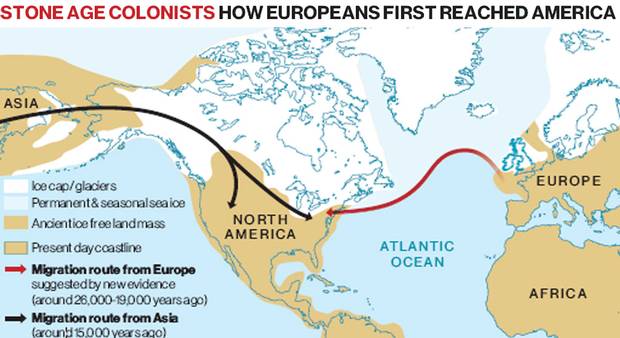 In the absence of other sites of similar age, Cinq-Mars' hypothesis remained highly controversial in the scientific community. Moreover, there was no evidence that the presence of horse, mammoth, bison and caribou bones in the Bluefish Caves was due to human activity. To set the record straight, Bourgeon examined the approximate 36,000 bone fragments culled from the site and preserved at the Canadian Museum of History in Gatineau -- an enormous undertaking that took her two years to complete. Comprehensive analysis of certain pieces at UdeM's Ecomorphology and Paleoanthropology Laboratory revealed undeniable traces of human activity in 15 bones. Around 20 other fragments also showed probable traces of the same type of activity. |
|
|
|
Post by Admin on Jan 13, 2019 23:31:56 GMT
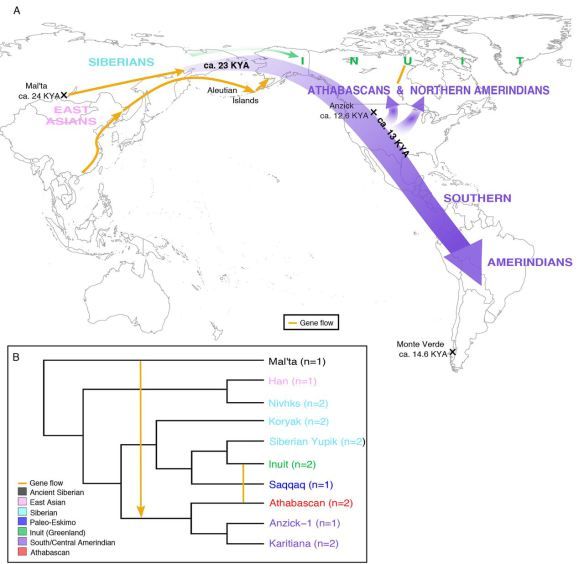 Mal’ta is a ~24,000 YBP old Siberian genome, recently described21 as a representative of ancient North Eurasians (ANE)22, a previously unknown northeastern branch of the Eurasian Paleolithic population. ANE contributed roughly 30–40% to the gene pool of Native Americans of the first settlement wave21 and about 50% to the Bronze Age Yamnaya culture in the Pontic-Caspian steppe6,23,24. Massive expansion of the Corded Ware culture around 5,000-4,000 YBP, originating from the Yamnaya source, introduced the ANE genetic pool into Central and Western Europe and thus reshaped its genetic landscape6,23. During the same period, the Afanasievo and Andronovo cultures, genetically similar to the Yamnaya culture, expanded into the Altai region (South Siberia) and later mixed with Siberian populations, giving rise to the Bronze Age Karasuk culture and later Iron Age cultures6. A global maximum of ANE ancestry occurs in Native Americans, with lower levels in peoples of more recent Beringian origin, i.e. indigenous populations of Chukotka, Kamchatka, the Aleutian Islands and the American Arctic21,22,25. In modern Europe, ANE genetic contribution is the highest in the Baltic region, on the East European Plain and in the North Caucasus6,22,23. However, little is known about the distribution of ANE ancestry in its Siberian homeland. According to a single f4 statistic, the Kets had the third highest value of ANE genetic contribution among all Siberian ethnic groups, preceded only by Chukchi and Koryaks26. Thus, we suggest that the Kets might represent the peak of ANE ancestry in Siberia; the hypothesis we tested extensively in this study. We also investigated continuity between the modern Kets and Altaians, and the ancient Bronze and Iron Age populations of the Altai region discussed above: the Karasuk culture samples dated to 3531-3261 YBP, and Iron Age samples roughly dated to 2900-1100 YBP6.  The 4,000 YBP genome from Greenland16 represents the Saqqaq archeological culture (4,500-2,800 YBP). This culture formed a continuum with Dorset and Norton cultures (2,500-1,000 YBP), collectively termed Paleo-Eskimo25. Paleo-Eskimos were culturally and genetically distinct from modern Inuits and Eskimos13,25. The Saqqaq culture is a part of the wider Arctic Small Tool tradition (ASTt) that had rapidly spread across Beringia and the American Arctic coastal regions (but not the interior) after 4,800 YBP, bringing pottery, bow and arrow to the northern North America13,15,27. According to the archaeological data, the likely source of this spread was located in Siberia, namely in the Lena River basin (probably, in the Bel’kachi culture13). On genetic grounds, Paleo-Eskimos were also argued to represent a separate migration into America16,25,28. ASTt spread coincided with the arrival of mitochondrial haplogroup D2 into America and the spread of haplogroup D2a29; the Saqqaq individual bore haplogroup D2a130. The closest modern relatives of Saqqaq occur among Beringian populations (Chukchi, Koryaks, Inuits25) and Siberian Nganasans16. In addition, Saqqaq has been linked to Na-Dene-speaking Chipewyans (16% contribution to this population modeled with admixture graphs28). However, mitochondrial haplogroup data25,30,31 argues against the proximity of Paleo-Eskimos to contemporary Na-Dene people13,15, primarily due to the very high frequency of haplogroup A in the latter32. Archeological evidence seems to support this argument13. There is no archaeological evidence of considerable trans-Beringian population movements between the inundation of the Bering Platform around 13,000-11,000 YBP and 4,800 YBP. Therefore, it is unlikely that the hypothetical Dene-Yeniseian language family has separated prior to 11,000 YBP, according to current concepts of time depth in language evolution13,15, and hence ASTt could be the vehicle spreading Dene-Yeniseian languages and genes from Siberia to Alaska and to the American Arctic13. However, as argued based on language phylogenetic trees33 in the framework of the Beringian standstill model29,34, the Dene-Yeniseian languages have originated in Beringia and spread in both directions. Irrespective of the migration direction and their relationship to contemporary Na-Dene groups, Paleo-Eskimos are the primary target for investigating genetic relationship with the Kets. In this study, we found that: (1) Kets and Selkups constitute a clade closely related to Nganasans; (2) Nganasans, Kets, Selkups, and Yukaghirs form a cluster of populations most closely related to Paleo-Eskimos in Siberia (not considering indigenous populations of Chukotka and Kamchatka); (3) unlike Nganasans, Kets derive roughly 30–40% of their ancestry from ancient North Eurasians; (4) Kets show genetic continuity with the hypothetical homeland of Yeniseian languages, as they are closely related to the ancient individuals of the Karasuk culture and to the later Iron Age individuals from the Altai. |
|


















